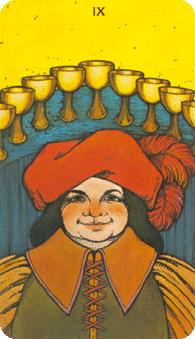9 of Cups: Say You'll Be Mine
(c) Cheryl Lynne Bradley 2006-7

“Love is our true destiny. We do not find the meaning of life by ourselves alone – we find it with another. We do not discover the secret of our lives merely by study and calculation in our own isolated meditations. The meaning of our life is a secret that has to be revealed to us in love, by the one we love. And if this love is unreal, the secret will not be found, the meaning will never reveal itself, the message will never be decoded. At best, we will receive a scrambled and partial message, one that will deceive and confuse us. We will never be fully real until we let ourselves fall in love – either with another human person or with God.“
From Love and Living by Thomas Merton, edited by Naomi Burton Stone and Br. Patrick Hart
(San Diego, New York, London: Harcourt Brace Jovanovich, 1985) Page 27
The 9 of Cups has a very special day associated with it, Valentine's Day. Valentine's is celebrated as a day of love and romance which suits the emotional satisfaction, wish fulfillment, satiety and long term, future oriented relationships traditionally associated with the 9 of Cups.
There are three St. Valentines' who were martyred and have the date of February 14 connected to them in various martyrologies. Two were Roman and died in the last half of the third century. One was a priest from Rome who died because he wouldn't give up Christianity. The other was a bishop from Interamna who died because he defied an order that young men shouldn't marry, as it made them poor soldiers, by performing secret weddings. They were buried on the Flaminian Way. The third was martyred in Africa and not much is known of him. The Flaminian Gate of Ancient Rome was called the Gate of St. Valentine in later years and is now called Porta del Popolo.
St. Valentine, the Roman priest, was killed on February 14, 269AD. This was a day for love lotteries to honour Juno in Roman times and also the day on which the Greeks honoured Eros (Cupid) who symbolized love and marriage. St. Valentine was a physician and a man of great compassion. His jailer brought his blind daughter to see if Valentine could help. Legend tells us that he left his jailer's daughter, whom he had become very close to, a goodbye note signed "from your Valentine" with a blossom in it and that this cured her blindness. While he sat in jail, many young children sent him notes and flower blossoms. This legend is likely the origin of the Valentine. In the year 496AD, February 14 was designated to honour him by Pope Gelasius. Over the years, St. Valentine became the Patron Saint of Lovers.
In Rome, February 15th was the Feast of Lupercalia festival. On the 14th, it wasa Pagan tradition to do name drawing. The names of young Roman girls were written on a piece of paper and put into jars. The young men would draw a girl's name from the jar and they would be partners for the rest of the festival. It was not unusual for these relationships to last, quite often they would fall in love and marry.
The Christian Church frowned on this and wanted to eliminate this Pagan practice. They did this by substituting the names of saints for those of young women. Since the Feast of Lupercalia began on the same day as St. Valentine's martyrdom they chose to create new feast day at the same time. We end up with a tradition from both of these practices still, people draw a saint's name to choose a patron saint for the coming year and young men and young women still do variations on the name drawing. A Valentine is cut in half and two containers are used, one for young women and one for young men. Each chooses from the opposite box, you find the person with the other half to be your partner for the Valentine party.
Our celebrations of Valentine's Day had their roots in France and England of the Middle Ages in the 14th century. Children would dress up as adults and go from door to door singing.
Good morning to you, valentine;
Curl your locks as I do mine---
Two before and three behind.
Good morning to you, valentine
February 14 was celebrated as the day birds came to pair and it became a day for exchanging love letters, hand made cards and tokens of esteem to your most beloved. Young men and young women also drew names from a bowl and would wear the name on their sleeve for a week -the origin of wearing your heart on your sleeve In the Welsh tradition, wooden love spoons were specially carved and given as gifts on February 14th. Hearts, keys and keyholes were the usual decorations on the spoons and represented "You unlock my heart!".
It was also believed that a young woman could tell what kind of man her future husband would be, by the first bird she saw on St. Valentine's Day. A black bird meant a clergyman or priest; a robin was a sailor; goldfinches or other yellow birds meant a rich man; a sparrow was a farmer; a bluebird meant a happy man; a crossbill was an argumentative man; and a dove was a sign of a good man. If she saw a woodpecker though, it meant that she wouldn't marry. The yellow crocus is the special flower for the day and it is also thought that if a young woman wears one on this special day, it will increase her chances for a future partner. Dreaming of receiving a Valentine is a reverse dream and a predictor of minor romantic problems or being let down by a friend. Dreaming of sending one means that a new door is opening to you and it will be very pleasant indeed.
One more thing, it is considered very unlucky to sign a Valentine, signing it defeats the purpose of sending it..... I knew I was doing something wrong.

















